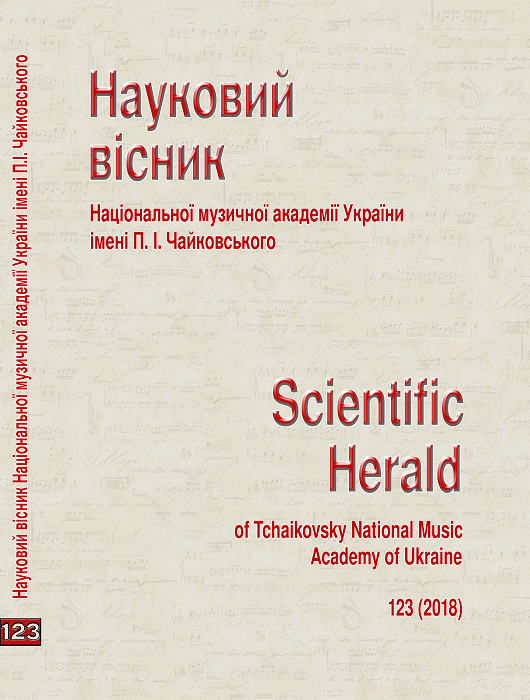Architectonic integrity of the polyphonic composition in the aspect of discourse-analysis
DOI:
https://doi.org/10.31318/2522-4190.2018.123.152412Keywords:
architectonics, integrity, non-imitative polyphony, imitative polyphony, discourse analysisAbstract
Relevance of the study. The application of the concepts of architectonics and tectonics to a polyphonic work in order to reveal the basic differences in the logical structure of imitative and non-imitative polyphony is undertaken for the first time.
Main objective of the study is a discourse analysis of the architectonic integrity of polyphonic work on the texture and thematic levels, in conditions of imitative and non-imitative polyphony.
Methodology of the study. The application of the discursive approach makes it possible to investigate the ratio of the general tectonic archetypes of a musical work (as a kind of “linguistic” principles with their typical model) and a polyphonic musical work in its chronotypologically defined genre-compositional discursive practice (as a givenness of a musical speech). The projection of the concept of “arched” architectonics (V. Moskalenko) to a polyphonic structure makes it possible to differentiate it into simultaneous (“contrapuntal”), succession ("polyphonic") and resultant (synthesizing) varieties, in consideration of the multipartite and specific branching of the texture landscape of the polyphonic work by horizontal, vertical and diagonal simultaneously.
Results and conclusions. The architectonic integrity of the polyphonic product is considered. It was revealed that the specificity of the polyphonic work, unlike the harmonious by its structure multivoiced music, is displayed primarily in its “texture landscape”. It found that in non-imitative polyphonic genres and forms (polymelodic and isorhythmic motets of the epochs Ars Antiqua and Ars Nova, contrapuntal or polythematical chorale arrangement on the cantus firmus, ostinato polyphonic variations, etc.), due to their many-tierity and gravitation toward compositional segmentation, the predominant effect of the simultaneous type of architectonic integrity is observed. In imitation polyphony (in particular, in ricercar or fugue), coordination “along the diagonal” causes the resulting type of architectonic thinking of the interpreter.
Downloads
References
Bakuto, S. V. (2016), Organization of artistic space in the art of Italian baroque: Concerti grossi A. Corelli and architectural ensemble. Candidate thesis. Krasnoyarsk [in Russian].
Domaschenko, A. V. (2006), On interpretation and explanation. Donetsk : DonNU, [in Russian].
Gulyanitskaya, N., S. (2016), The experience of discourse-analysis of modern music. Uchenyie zapiski RAM im. Gnesinyih. [Scholarly papers of Russian Gnesins Academy of Music]. Vol. 3 (18), pp. 3–11 [in Russian].
Krasnikova, T. N. (2008), Texture in the music of the XX century. Doctoral thesis. Moscow [in Russian].
Losev, A. F. (1994), The problem of artistic style. Kyiv : Collegium, Kievskaya Akademiya Evrobiznesa [in Russian].
Monich, M. L. (2015), “The initial construction as an encoded message”. OPERA MUSICOLOGICA. Vol. 3 [25], pp. 78–87 [in Russian].
Moryeva, Ye. O. (2005), Music work as a kind of discursive practice. Extended abstract of Candidate’s thesis. Kyiv [in Ukrainian].
Moskalenko, V. H. (1994), Theoretical and methodological aspects of musical interpretation. Extended abstract of Doctoral thesis. Kyiv [in Ukrainian].
Moskalenko, V. H. (2008), Analysis in the foreshortening of the musicological interpretation. Chasopys Natsional’noyi muzychnoyi akademiyi Ukrayiny imeni P. I. Chaykovs’koho [Journal of P. I. Tchaikovsky National Music Academy of Ukraine]. Vol. 1, pp. 106–111 [in Ukrainian].
Moskalenko, V. H. (2011), Interpretation of the formula of artistic whole. Chasopys Natsional’noyi muzychnoyi akademiyi Ukrayiny imeni P. I. Chaykovs’koho [Journal of P. I. Tchaikovsky National Music Academy of Ukraine]. Vol. 2 (11), pp. 11–16 [in Ukrainian].
Pyaskovs’kyy, I. B. (2009), The musical form as discourse. Mystets’ki obriyi [Art horizons]. Vol. 2 (11), pp. 342–353 [in Ukrainian].
Pyaskovs’kyy, I. B. (2011), Interpretive mechanisms in the imitative polyphony. Chasopys Natsional’noyi muzychnoyi akademiyi Ukrayiny imeni P. I. Chaykovs’koho [Journal of P. I. Tchaikovsky National Music Academy of Ukraine]. Vol. 1 (10), pp. 31–39 [in Ukrainian].
Solans’kyy, S. S. (2012), Art and interpretative discourse of globalized space. Tavriys’ki studiyi. Kul’turolohiya [Taurida Studios. Сulturology]. Vol. 1, pp. 1–8 [in Ukrainian].
Syuta, B. O. (2007), The principles of artistic integrity in the work of Ukrainian and Polish composers of the 1970–1990 years. Extended abstract of Doctoral thesis. Kyiv [in Ukrainian].
Syuta, B. O. (2010), The discourse in music and the theory of discours- analysis in musical science. Studiyi mystetstvoznavchi [Researches of Fine Arts]. Vol. 1(29), pp. 35–42 [in Ukrainian].
Taneev, S. I. (1959), The invertible counterpoint of strict writing. Moskow: Gos. muz. izd-vo [in Russian].
Volkova, E. V. (1988), The work of art in the world of artistic culture. Moskow: Iskusstvo [in Russian].
Downloads
Published
How to Cite
Issue
Section
License
Our journal abides by the CREATIVE COMMONS copyright rights and permissions for open access journals.
Authors, who are published in this journal, agree to the following conditions:
The authors reserve the right to authorship of the work and pass the first publication right of this work to the journal under the terms of a Creative Commons Attribution License, which allows others to freely distribute the published research with the obligatory reference to the authors of the original work and the first publication of the work in this journal.
The authors have the right to conclude separate supplement agreements that relate to non-exclusive work distribution in the form in which it has been published by the journal (for example, to upload the work to the online storage of the journal or publish it as part of a monograph), provided that the reference to the first publication of the work in this journal is included.




